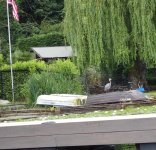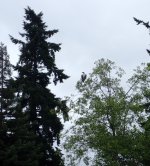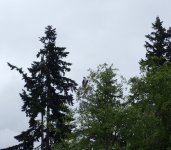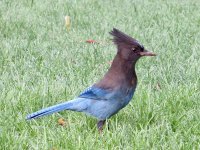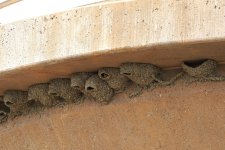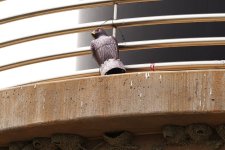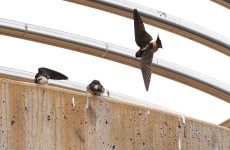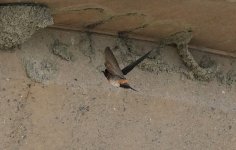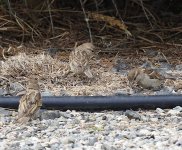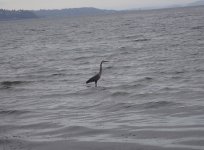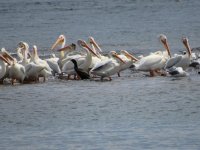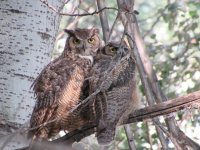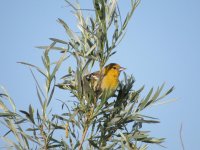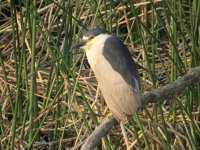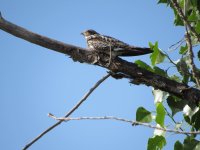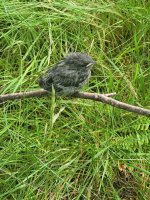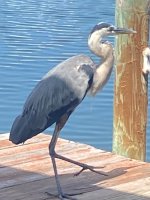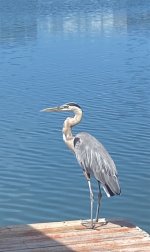Navigation
Install the app
How to install the app on iOS
Follow along with the video below to see how to install our site as a web app on your home screen.
Note: This feature may not be available in some browsers.
More options
Style variation
You are using an out of date browser. It may not display this or other websites correctly.
You should upgrade or use an alternative browser.
You should upgrade or use an alternative browser.
Got any bird pics?
- Thread starter Wadin' Boot
- Start date
The osprey was taking notes from the master...This Osprey saw me catch a fish so it stopped to check things out in the tree above me.
View attachment 157495View attachment 157496
Steve
These Sandhill Cranes Have Adopted a Canada Gosling, and Birders Have Flocked to Watch the Strange Family https://share.google/XRVkkOuNnP00zW6mU
Buzzy
I prefer to call them strike indicators.
Rich - I really like the great horned owl(s) picture! Very cool!Some recent local birds
White Pelicans and a cormorantView attachment 158582
Great Horned OwlsView attachment 158583
Female Bullock's Oriole
View attachment 158584
Black Crowned Night HeronView attachment 158585
Nighthawk
View attachment 158586
Yellow Warbler
View attachment 158587
Bonefish Jack
Steelhead
Western tanager is one of our most colorful, not too uncommon birds. I always enjoy seeing them. I saw one feeding on elderberry and snapped a few phone pics. I continue to provide the helpful counterpoint of crappy pics to help the good ones shine a little more, lest we become complacent and take our local talent for granted.
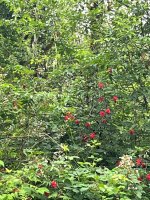

Attachments
That tananger was hard to spot but I found it!
Now there's a big beautiful bill.
McLane Creek, Late June 2025. It may seem that the flamboyant duck drakes have disappeared from their usual locations. This is only partly true. The flamboyant part has disappeared, but the drakes are still there, but in their more cryptic “eclipse” plumage. Depending on species, birds molt once or twice a year. Adult ducks typically undergo two molts a year, though these may be partial in some individuals (see here). The hens of most duck species start a gradual molt in the spring, often beginning the process before breeding; molted downy feathers are added to the nest as insulation for the eggs. Depending on when they start to replace their flight feathers, hens may have limited flying ability until these feathers grow out.
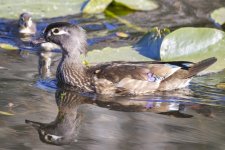
These hens will molt again gradually in the summer after they have completed shepherding their ducklings to independence.
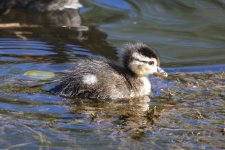
Drakes will molt in late spring / early summer after the last possibility of breeding has passed. They will shed their bright breeding plumage (like these wood duck drakes from McLane Creek in May)
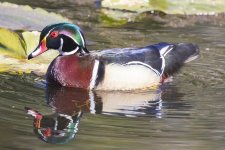
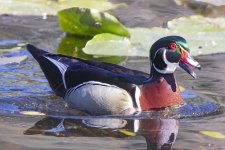
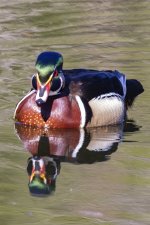
to their drabber eclipse plumage (wood duck drake at McLane Creek in late June).
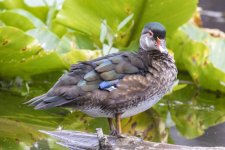
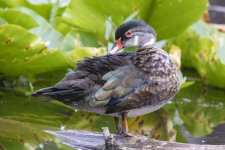
The bill color and red eye are clear markers that these are drakes. Otherwise, the eclipse plumages are more similar to the hens’ plumage and for the same reason - so that the males are less obvious to potential predators when there is no selective advantage for the bright breeding plumage. It is this balance between individual selection and sexual selection that fascinated Charles Darwin (The Descent of Man and Selection in Relation to Sex).
There must be powerful selective factors favoring the development of this short-term (a few months?) plumage as they will start to molt again (either partial or full) into their bright breeding plumage by early fall. Molting is expensive energetically and is a substantial drain on protein stores. Up to a quarter of bird’s total protein mass may be devoted to this replacement process (see here). Some bird species even migrate to specific habitats that have the energetic and protein resources to support growth of the replacement feathers
Ruddy ducks are somewhat different from other ducks in their molting pattern. Drakes retain their drabber plumage through fall and early winter (not McLane Creek...)
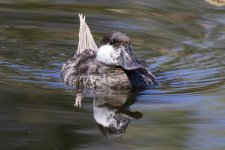
before transitioning into their brighter breeding plumage by mid-winter / spring (Tucson area in late March).
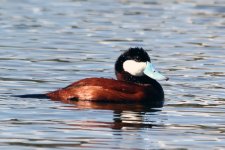
Hen ruddy ducks also appear to molt later than in many other duck species, although this is less obvious.
Steve

These hens will molt again gradually in the summer after they have completed shepherding their ducklings to independence.

Drakes will molt in late spring / early summer after the last possibility of breeding has passed. They will shed their bright breeding plumage (like these wood duck drakes from McLane Creek in May)



to their drabber eclipse plumage (wood duck drake at McLane Creek in late June).


The bill color and red eye are clear markers that these are drakes. Otherwise, the eclipse plumages are more similar to the hens’ plumage and for the same reason - so that the males are less obvious to potential predators when there is no selective advantage for the bright breeding plumage. It is this balance between individual selection and sexual selection that fascinated Charles Darwin (The Descent of Man and Selection in Relation to Sex).
There must be powerful selective factors favoring the development of this short-term (a few months?) plumage as they will start to molt again (either partial or full) into their bright breeding plumage by early fall. Molting is expensive energetically and is a substantial drain on protein stores. Up to a quarter of bird’s total protein mass may be devoted to this replacement process (see here). Some bird species even migrate to specific habitats that have the energetic and protein resources to support growth of the replacement feathers
Ruddy ducks are somewhat different from other ducks in their molting pattern. Drakes retain their drabber plumage through fall and early winter (not McLane Creek...)

before transitioning into their brighter breeding plumage by mid-winter / spring (Tucson area in late March).

Hen ruddy ducks also appear to molt later than in many other duck species, although this is less obvious.
Steve
Jim F.
Still a Genuine Montana Fossil
Drake Woodies are indeed gorgeous . . . kind of like the Eastern Brook of the duck world imho.Adult ducks typically undergo two molts a year
Great pics Steve - I always enjoy your images and narrative.
There are a few North American puddle duck species (as well as geese) that undergo sex segregated pre molt "mini" migrations. Mallard and Pintail males will gather and large groups in specific habitats while undergoing the flightless portion of their molt. Pintail prefer large open wetlands in the Parklands and Prairies of Canada and interior Alaska while mallards seem to prefer marsh complexes with ample emergent cover. These birds will travel hundreds of miles to gather at specific sites.
Drake pintail in particular continue to stay segregated as they come out of molt and are often the first migrants to arrive on the wintering grounds as early as late July or early August. We always saw our first migrant pintail during the first week of August and it was almost always drakes only. Hens with their broods tend to arrive weeks later.
There are a few North American puddle duck species (as well as geese) that undergo sex segregated pre molt "mini" migrations. Mallard and Pintail males will gather and large groups in specific habitats while undergoing the flightless portion of their molt. Pintail prefer large open wetlands in the Parklands and Prairies of Canada and interior Alaska while mallards seem to prefer marsh complexes with ample emergent cover. These birds will travel hundreds of miles to gather at specific sites.
Drake pintail in particular continue to stay segregated as they come out of molt and are often the first migrants to arrive on the wintering grounds as early as late July or early August. We always saw our first migrant pintail during the first week of August and it was almost always drakes only. Hens with their broods tend to arrive weeks later.
Great added information. I had read that some songbird species have mini molt-migrations, but I hadn't seen that this phenomenon also applied to some duck species. And I didn't know that hens and their broods migrated together.Great pics Steve - I always enjoy your images and narrative.
There are a few North American puddle duck species (as well as geese) that undergo sex segregated pre molt "mini" migrations. Mallard and Pintail males will gather and large groups in specific habitats while undergoing the flightless portion of their molt. Pintail prefer large open wetlands in the Parklands and Prairies of Canada and interior Alaska while mallards seem to prefer marsh complexes with ample emergent cover. These birds will travel hundreds of miles to gather at specific sites.
Drake pintail in particular continue to stay segregated as they come out of molt and are often the first migrants to arrive on the wintering grounds as early as late July or early August. We always saw our first migrant pintail during the first week of August and it was almost always drakes only. Hens with their broods tend to arrive weeks later.
Thank you,
Steve

